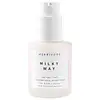What's inside
What's inside
 Key Ingredients
Key Ingredients

 Benefits
Benefits

 Concerns
Concerns

No concerns
 Ingredients Side-by-side
Ingredients Side-by-side

Water
Skin ConditioningPropanediol
SolventSimmondsia Chinensis Seed Oil
EmollientSodium Hydroxide
BufferingLactic Acid
BufferingGlycolic Acid
BufferingGluconolactone
Skin ConditioningCetearyl Olivate
Sorbitan Olivate
EmulsifyingOctyldodecanol
EmollientGlycerin
HumectantMalic Acid
BufferingTartaric Acid
BufferingCitric Acid
BufferingSqualane
EmollientAvena Sativa Kernel Extract
AbrasiveCeramide NP
Skin ConditioningCeramide AP
Skin ConditioningMicrocitrus Australasica Fruit Extract
Tremella Fuciformis Sporocarp Extract
AntioxidantHyaluronic Acid
Humectant1,2-Hexanediol
Skin ConditioningXanthan Gum
EmulsifyingDiheptyl Succinate
EmollientCapryloyl Glycerin/Sebacic Acid Copolymer
Skin ConditioningOryza Sativa Bran Extract
Skin ConditioningSclerotium Gum
Emulsion StabilisingLecithin
EmollientPullulan
Caprylhydroxamic Acid
Trisodium Ethylenediamine Disuccinate
Helianthus Annuus Seed Oil
EmollientTriethyl Citrate
MaskingRosmarinus Officinalis Leaf Extract
AntimicrobialTocopherol
AntioxidantSilica
Abrasive2,3-Butanediol
HumectantGlyceryl Stearate
EmollientPrunus Amygdalus Dulcis Oil
Skin ConditioningSodium Lactate
BufferingHydrogenated Lecithin
EmulsifyingGamma-Octalactone
PerfumingVanillin
MaskingGlyceryl Caprylate
EmollientIsoamyl Acetate
SolventBenzaldehyde
MaskingAnisaldehyde
MaskingMaltol
MaskingPhytosphingosine
Skin ConditioningEthylhexylglycerin
Skin ConditioningDimethylhydroxy Furanone
MaskingWater, Propanediol, Simmondsia Chinensis Seed Oil, Sodium Hydroxide, Lactic Acid, Glycolic Acid, Gluconolactone, Cetearyl Olivate, Sorbitan Olivate, Octyldodecanol, Glycerin, Malic Acid, Tartaric Acid, Citric Acid, Squalane, Avena Sativa Kernel Extract, Ceramide NP, Ceramide AP, Microcitrus Australasica Fruit Extract, Tremella Fuciformis Sporocarp Extract, Hyaluronic Acid, 1,2-Hexanediol, Xanthan Gum, Diheptyl Succinate, Capryloyl Glycerin/Sebacic Acid Copolymer, Oryza Sativa Bran Extract, Sclerotium Gum, Lecithin, Pullulan, Caprylhydroxamic Acid, Trisodium Ethylenediamine Disuccinate, Helianthus Annuus Seed Oil, Triethyl Citrate, Rosmarinus Officinalis Leaf Extract, Tocopherol, Silica, 2,3-Butanediol, Glyceryl Stearate, Prunus Amygdalus Dulcis Oil, Sodium Lactate, Hydrogenated Lecithin, Gamma-Octalactone, Vanillin, Glyceryl Caprylate, Isoamyl Acetate, Benzaldehyde, Anisaldehyde, Maltol, Phytosphingosine, Ethylhexylglycerin, Dimethylhydroxy Furanone
Rosa Damascena Flower Water
MaskingHibiscus Syriacus Flower Extract
AntioxidantHyaluronic Acid
HumectantAloe Barbadensis Leaf Water
MaskingWater
Skin ConditioningLeuconostoc/Radish Root Ferment Filtrate
AntimicrobialGlycerin
HumectantSodium Hyaluronate
HumectantSodium Phytate
Cocos Nucifera Fruit Powder
Skin ConditioningHibiscus Sabdariffa Flower Extract
Skin ConditioningMelia Azadirachta Leaf Extract
Skin ConditioningMelia Azadirachta Flower Extract
Skin ConditioningCoccinia Indica Fruit Extract
Skin ConditioningRosa Damascena Flower Water, Hibiscus Syriacus Flower Extract, Hyaluronic Acid, Aloe Barbadensis Leaf Water, Water, Leuconostoc/Radish Root Ferment Filtrate, Glycerin, Sodium Hyaluronate, Sodium Phytate, Cocos Nucifera Fruit Powder, Hibiscus Sabdariffa Flower Extract, Melia Azadirachta Leaf Extract, Melia Azadirachta Flower Extract, Coccinia Indica Fruit Extract
Ingredients Explained
These ingredients are found in both products.
Ingredients higher up in an ingredient list are typically present in a larger amount.
Glycerin is already naturally found in your skin. It helps moisturize and protect your skin.
A study from 2016 found glycerin to be more effective as a humectant than AHAs and hyaluronic acid.
As a humectant, it helps the skin stay hydrated by pulling moisture to your skin. The low molecular weight of glycerin allows it to pull moisture into the deeper layers of your skin.
Hydrated skin improves your skin barrier; Your skin barrier helps protect against irritants and bacteria.
Glycerin has also been found to have antimicrobial and antiviral properties. Due to these properties, glycerin is often used in wound and burn treatments.
In cosmetics, glycerin is usually derived from plants such as soybean or palm. However, it can also be sourced from animals, such as tallow or animal fat.
This ingredient is organic, colorless, odorless, and non-toxic.
Glycerin is the name for this ingredient in American English. British English uses Glycerol/Glycerine.
Learn more about GlycerinHyaluronic acid is naturally found in healthy skin. It is a humectant, meaning it draws moisture to your skin.
This ingredient helps hydrate, soothe, and protect the skin.
What makes hyaluronic acid so hydrating? It has the capacity to bind or hold large amounts of water.
Fun fact: It is already naturally found in our bodies, such as the fluids of our eyes and our joints.
Studies find this ingredient to have anti-inflammatory and anti-microbial properties. This can help speed up wound-healing.
Hyaluronic acid can be irritating if the molecule has a low-molecular weight, or if the molecules are small.
One study found low-molecular weight hyaluronic acid to be pro-inflammatory, meaning some people may experience irritation. This is because our bodies use hyaluronic acid in the wound-healing process to signal to our bodies, via irritation, that something needs healing.
The same study found high-molecular weight hyaluronic acid to be anti-inflammatory.
These are some other common types of Hyaluronic Acid:
Learn more about Hyaluronic AcidWater. It's the most common cosmetic ingredient of all. You'll usually see it at the top of ingredient lists, meaning that it makes up the largest part of the product.
So why is it so popular? Water most often acts as a solvent - this means that it helps dissolve other ingredients into the formulation.
You'll also recognize water as that liquid we all need to stay alive. If you see this, drink a glass of water. Stay hydrated!
Learn more about Water